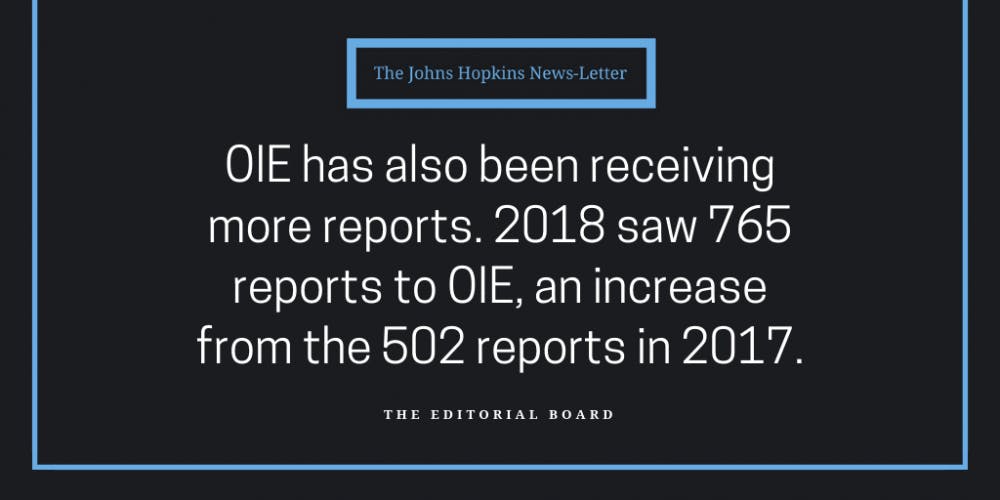When the Office of Institutional Equity (OIE) issued its first annual report on sexual misconduct at Hopkins last year, we were upset but not surprised by the findings. The report indicated that there was a lack of awareness among students around OIE’s services, a doubling in sexual misconduct reports from 2016 to 2017 and a majority of cases taking eight months or longer to investigate.
We appreciated that OIE had released the report. It was an important step in increasing transparency and awareness about its services. Without such efforts, we would be less able to understand how OIE conducts investigations, and how to hold it and the University accountable.
It is encouraging that the University is continuing to be more transparent this year. On Tuesday, OIE released its second annual report. The report details all of the complaints OIE received last year about sexual misconduct, discrimination and other forms of harassment. It also describes how OIE handles or resolves these complaints.
We also applaud their efforts to expand the scope of these reports. The University recently released the results of its third Campus Climate Survey, which incorporated responses from 4,084 undergraduate and graduate students. For the first time, the University participated in the Association of American Universities (AAU) survey about sexual misconduct, along with 32 other higher education institutions. This allows us to compare the results of the Hopkins Climate Survey to the aggregate AAU results, and to see how Hopkins measures up to its peer institutions.
Some of the findings from this year’s report, however, indicate that progress at Hopkins has been slower than we’d hoped. Relative to our peer institutions, we can do better.
To begin with, only 43 percent of this year’s Climate Survey respondents believed that campus officials would conduct fair investigations. This number marks a significant decrease from the 63 percent who responded this way in last year’s survey, and is lower than the AAU average of 51 percent. This begs the question: What caused this 20 percent drop in student trust in the administration?
Additionally, 71 percent of survey respondents reported having completed or attended at least one training or information session related to sexual assault and misconduct during their time at Hopkins. Still, few students knew how the University defines sexual violence, how to reach out for help or how to file a report. For each of these cases, less than 30 percent of respondents felt “very/extremely knowledgeable.” These statistics were lower than the AAU percentages as well.
OIE has also been receiving more reports. 2018 saw 765 reports to OIE, an increase from the 502 reports in 2017. This increase might raise concern, but it could also be because incidents were under reported last year. Students may have become more willing to report their experiences. Furthermore, with the rise of the #MeToo movement, there is perhaps a greater understanding of the definition of consent.
Still, while the number of reports and investigations has increased, OIE resolved more formal investigations than they did last year. There has been a 160 percent increase between 2017 and 2018 in the number of reports that were closed following an assessment. While we do not know the exact circumstances in which these cases closed, we hope that they reflect OIE’s ability to more effectively manage reports.
We are happy to see the University responding to previous reports by taking measures to improve resources for survivors of sexual violence. In 2018, OIE increased the size of their staff to include the addition of two new investigator positions. Kevin Shollenberger became the University’s first vice provost for health and wellbeing and is working with the Provost’s Sexual Violence Advisory Committee to improve educational resources and preventative measures.
The responsibility to combat sexual misconduct, however, should not rest solely with OIE. All departments at Hopkins can do more to address the issue. There are simple ways to bring awareness to the forefront.
The Orientation and First-Year Experience team should include sessions detailing on campus resources for sexual misconduct. Community Living should stress the availability of these resources as well. Resident Advisors should encourage their students to fill out Campus Climate Surveys in the spring. Simply keeping students informed will show that the University genuinely cares and wants to make a difference. We hope that this will ensure that more than 30 percent of students know about on campus resources.
We are glad that Hopkins keeps us informed about the numbers regarding sexual misconduct. We are proud that the school recognizes the role it plays in maintaining a safe and comfortable campus culture. But there is always more to be done. Hopkins must ensure that all students — from the undergraduate to the professional level — receive training on sexual misconduct resources. The University must become a resource that every student feels comfortable turning to for help.
Taking the Campus Climate Survey and compiling data from OIE are the first steps. It is a good sign that Hopkins is continuing these trends from last year. While there are still many improvements to be made, we are hopeful that Hopkins will make sure they are accomplished.
If you or someone you know has experienced sexual violence, you can seek help from the following Hopkins-specific, local or national confidential resources: JHU Sexual Assault Resource Unit (SARU) 24/7 Peer Crisis Support Hotline — (410) 516-7887; JHU 24/7 Sexual Assault Helpline — (410) 516-7333; TurnAround Inc 24/7 Helpline — (443) 279-0379; Rape, Abuse & Incest National Network (RAINN) 24/7 Sexual Assault Hotline — 1 (800) 656-4673.





